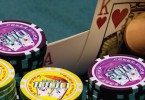Tournament poker has long been a game that has pushed the boundaries. Although it is widely loved by the millions around the globe that play every day, its greatest lure is the promise of a life-changing pay day.
Take the World Series of Poker as an example. A total of 6,372 players have forked out the $10,000 entry fee (or qualified via satellite) for this year’s WSOP Main Event and it’s easy to understand why when you look at the first prize of more than US$8 million that awaits the victor.
The WSOP is the pinnacle of the poker world and it’s an amazing spectacle to walk into the Rio All-Suite Casino in Las Vegas each summer to witness the incredible sea of people all there for the game we love.

England’s Sam Trickett is a regular in big buy-in tournaments around the world
But how much is too much when it comes to poker tournaments?
With more and more big events cropping up around the globe – WSOP Europe and WSOP A-PAC, the Aussie Millions, WPT, EPT and APPT among them – the fight to stand out from the crowd is becoming more dogged.
The solution, it seems, is to offer bigger buy-in events. In 2006, the Aussie Millions launched the $100k Challenge – an AU$100,000 buy-in event that was touted as the biggest buy-in tournament in the world.
A few years later, after other tournaments began matching them, the Aussie Millions launched a $250,000 buy-in Super High Roller event in order to reclaim the crown. It didn’t last long. Last year the WSOP held the world’s first ever US$1 million event – The Big One for One Drop – which attracted a field of 48 professional players and businessmen and a whopping prize pool of US$42 million.
The tournament certainly achieved its goal of attracting widespread publicity with Antonio Esfandiari claiming he record US$18 million first prize, but at what cost?
It used to be that poker players dreamed of moving up the list of all-time tournament money winners. A few years ago – before all these events began cropping up with increasing regularity – Australia’s 2005 WSOP Main Event winner Joe Hachem told me this was one of his primary career goals. But that was back when it was a contest open to all.

Antonio Esfandiari scored a US$18 million payday after winning the Big One for One Drop at the 2012 WSOP
For most, playing in such huge buy-in events is a pipe dream that can simply never happen.
Instead, the all-time money list is now a shoot-out between the elite few who can afford to buy-in in the first place. It is no longer a record of lifetime achievement at the poker table.
Esfandiari is a great poker player with some tremendous achievements to his name, but should he sit at the top of the all-time money list? He currently holds the No.1 spot with a bit over US$25 million, but three-quarters of that came from a single event in which he had to beat just 48 players to win. Hachem beat around 5,500 to win US$7.5 million in 2005. Take out Esfandiari’s massive pay day and he would lag well behind Hachem’s career earnings of $US11 million.
It’s a skewed playing field.
Perhaps it is time we separated the winnings for big buy-in tournaments from the rest? Do we set a limit of, say, $50,000? Less even?
Then again, does it even matter? Are we making a mountain out of a molehill?
Either way, it’s an interesting debate and some food for thought as we head deep into this year’s WSOP Main Event.







